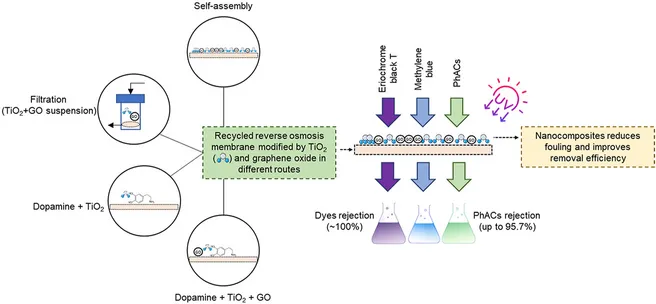Despite the widespread use of membrane separation processes for water treatment, operation costs and fouling still restrict their application. Costs can be overcome by recycled membranes whereas fouling can be mitigated by membrane modification. In this work, the performance of recycled reverse osmosis membranes modified by greener titanium dioxide (TiO2) and graphene oxide (GO) in different modification routes were investigated and compared. The use of recycled membranes as a support acted more than a strategy for costs reduction, but also as an alternative for solid waste reduction. Low adhesion of nanoparticulate materials to the membrane surfaces were verified in depositions by self-assembly, whereas filtration and modification with dopamine generated membranes with well adhered and homogeneous layers. Considering the stability, permeability, and rejection efficiency of dyes as model substrates, the membranes modified with the aid of dopamine-TiO2-GO were the most promising. The nanomaterials increased the membrane hydrophilicity and formed a hydrated layer that repels the organic contaminants and reduces fouling. Besides membrane rejection, adsorption (contribution: ∼10%) and photocatalysis (contribution: ∼20%) were additional mechanisms for pollutants removal by the modified membranes. The photocatalytic membrane modified with dopamine-TiO2-GO was furthermore evaluated for the removal of six different pharmaceutical active compounds (PhACs), noticing gains in terms of removal efficiency (up to 95.7%) and fouling mitigation for the modified membrane compared to the original membranes. The photocatalytic activity still contributed to a simultaneous degradation of PhACs avoiding the generation of a concentrated stream for further disposal.
